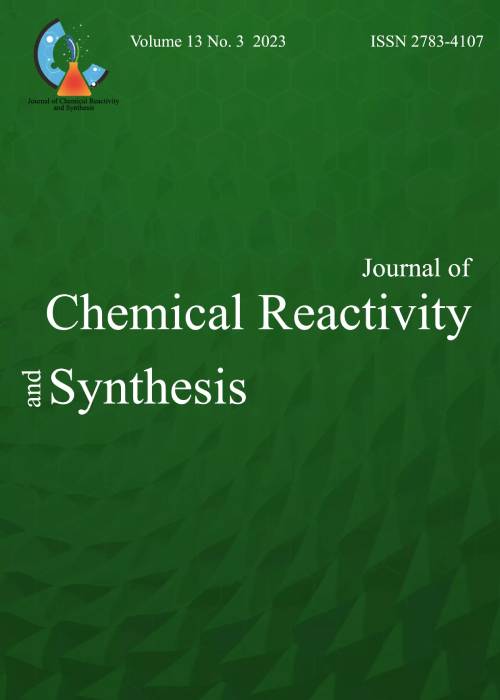فهرست مطالب
Journal of Chemical Reactivity and Synthesis
Volume:2 Issue: 1, Winter 2012
- تاریخ انتشار: 1390/11/12
- تعداد عناوین: 7
-
Synthesis of alkyl 2-(4-oxoquinazolin-3(4H)-yl) acrylate by nucleophilic additionof alkyl propiolates catalysed by Ph3PPages 9-114-Hydroxyquinazoline undergoes neutral conditions with alkyl propiolates in the presence of triphenylphosphine (0.26g), and by α substituation the corresponding 2-(4-oxoquinazolin-3(4H)-yl acrylate was obtained in good yields.Keywords: 4-Hydroxyquinazoline, alkylacrylat, Alkyl propiolates, Triphenylphosphine
-
Nanoalumina sulfonic acid catalyzed rapid N-formylation under solvent-free conditionsPages 12-16A rapid and chemoselective method for the N-formylation of structurally diverse anilines with formic acid using nanoalumina sulfonic acid (NASA) at 70oC under solvent-free condition has been developed. The catalyst was found to be compatible with different functional groups and the formylation proceeded smoothly with anilines bearing electron withdrawing as well as electron donating substituents.Keywords: Formamide, Aniline, Amino-protection, Nanoalumina sulfonic acid
-
Michael addition of Pyrrole and indole to α,β- unsaturated compounds in the Presence of oxalic acidPages 17-21A Simple and efficient method for Michael addition of pyrrole and indole to α,β- un saturated compounds has been developed in the presence of oxalic acid under refluxing reaction condition was achieved.Keywords: Michael addition, Pyrrole, indole, Oxalicacid, β- unsaturated compounds
-
Microwave-assisted thioacetalization of carbonyl compounds using Al-MCM-41 as an efficient heterogeneous catalystPages 22-27In this project various types of carbonyl compounds were efficiently converted to their corresponding 1,3-oxathiolanes with 2-mercaptoethanol in the presence of catalytic amount of Al-MCM-41 with microwave energy. The catalyst can be reused several times without loss of its catalytic activity. Very short reaction times, reusability of the catalyst, and easy workup are noteworthy advantages of this method.Keywords: Al-MCM-41, Heterogeneous catalyst, 3-oxathiolanes, Carbonyl compound, microwave energy
-
Phosphosulfonic acid as an soild acid supported on nanosilica extracted from rice husk in Polyhydroqinilion SynthesisPages 28-35Phosphosulfonic acid as a multi solid site was easily prepared from the reaction of ammonium dihydrogen phosphate with chlorosulfonic acid in CCl4and for improved its catalytic activity was supported nano Silica was extracted from husk rice contains about 95% of Silica the size of extracted nano silica was determined by SEM efficiency of this solid acid in four component condensation reaction of aromatic aldehydes, dimidone, diketon, an ammonium acetate was investigated the results were clearly shown that aldehydes having electron withdrawing and electron donating groups were efficiently converted to the corresponding Polyhydroqinilion the high yields and short time products were produced at 110 0C under solvent free conditions.Keywords: nanosilica, Phosphosulfonic, Polyhydroquinolin, Hantzsh condensation
-
D-tartaric acid: a novel catalyst for green and efficient synthesis of 3,4-dihydropyrimidin-2(1H)-ones by Biginelli reaction under solvent-free conditionsPages 36-38D-tartaric acid is successfully used as a green and efficient catalyst for the synthesis of 3,4-dihydropyrimidin-2(1H)-ones under solvent-free conditions. The developed method has many advantages, including devoid of harmful catalyst and solvents, high yield and easily work-up.Keywords: D-tartaric acid, Solvent-free conditions, 4-Dihydropyrimidin-2(1H)-ones, Multicomponent reaction, organo catalyst
-
A One-Pot Synthesis of 1,8- Dioxodecahydroacridine Using Zinc Chloride Silica gel-supported Catalyst under Solvent-Free ConditionsPages 39-44Zinc chloride silica gel-supported was found to be an efficient, inexpensive catalyst for the synthesis of 1,8-dioxodecahydroacridines via one-pot three-component condensation of aryl aldehydes, dimedone, andammonium acetate in high yields. The described novel synthetic method propose several advantages of safety, mild condition, short reaction times, high yields, simplicityand easy workup compared to the traditional method of synthesis.


